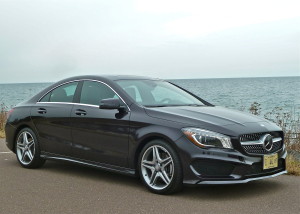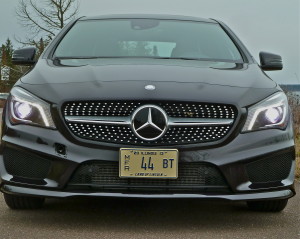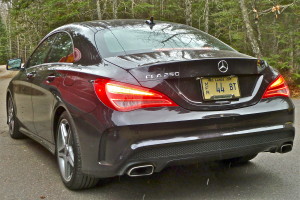CLA250 Tops Price, Style Standards
By John Gilbert
Amid the exhaustive competition for assorted 2014 Car of the Year awards, the Mercedes-Benz CLA250 will NOT win any of them. An objective and discerning person with the chance to test-drive one might be left with one obvious question: “Why not?”
From the standpoint of style, technology, driving pleasure, agility, comfort, and the astounding tandem of low sticker price and off-the-scale real-world fuel economy — a pair of attributes not usually mentioned with any Mercedes model — the CLA establishes some true benchmarks.
If someone suggested you could buy the best-looking sedan Mercedes ever produced, built on the first winter-beating front-wheel-drive sedan platform and capable of well over 30 miles per gallon for $50,000, you might be impressed. When you’re told it can be had for just a smidgeon over $30,000, you might knock over the salesman’s desk in your zeal to sign on the dotted line before such an obvious mistake could be corrected.
But it’s true. The Mercedes CLA250 starts at $30,000, and climbs only gradually with enticing stand-alone options instead of the usual costly package-price deals. True, you can get an AMG super-hot version for $50,000, and it is truly a world-class screamer. But why bother?
The base CLA250 comes with a surprisingly potent 2.0-liter 4-cylinder, with direct injection, variable valve-timing, and a modest-sounding 208-horsepower and 258-foot-pounds of torque powerplant, directed via a 7-speed twin-clutch automatic transmission with steering-wheel paddles for manual control. In one ofd those surprisingly German things, the power numbers don’t matter; the car is startlingly swift. Driving in strictly city traffic with a lot of hills, I stayed over 33 miles per gallon, and on one lengthy freeway trip at 70-75 mph, it rose to over 38 mpg, which is the top mark in its EPA highway estimate.
A few years ago, Mercedes shocked the automotive world by departing from its standard array from compact to large of C-Class, E-Class, S-Class sedans to unveil a CLS sedan, which immediately became known as a “4-door coupe” for its rakish and sleek lines that resembled a coupe more than a sedan.
My reaction was simple, and Newcarpicks.com declared that the CLS was the world’s most “stunningly beautiful sedan.” Over the years, I had bestowed that honor on the old BMW 7-Series, and later the remarkably sophisticated Acura TL, but as those models changed in the later-2000s, the pedestal was left wide open for the CLS. Competitors criticized the shape, but then scurried to copy it. The Audi A7, and the BMW 650 and new 4-Series are examples of 4-door-coupe shapes, as is the bargain Volkswagen CC.
Two years ago, I was dismayed to see that Mercedes had redesigned the CLS and, befitting the theory that BMW and Acura had recently proven, it is very difficult to improve on perfection, and much easier to go the other direction. I like the new CLS, but it dropped from the ranks of the most beautiful in the Gilbert analysis. For 2013, I bestowed that honor on the Ford Fusion, for its sleek lines I called the most attractive ever put on a sedan built by one of our Detroit Big Three. At the 2013 Detroit Auto Show, I had the chance to attend an annual Mercedes gathering on the eve of the start of press preview days. It was there that Mercedes rolled out the CLA. It caused me to rank it the No. 1 attraction at the show, even over and above the dramatic new Corvette Stingray.
In retrospect, Mercedes may have snookered us all, altering the coupe-like style of the CLS while making it more of a luxury sedan, and knowing it was planning the CLA blockbuster to assume that shape.
As a member of the jury that votes on the North American Car and Truck/Utility of the Year, I have no quarrel with the 50-person majority determination of the Corvette, Cadillac CTS, and the high-tech subcompact Mazda3 as our three finalists. Nor am I surprised that Motor Trend magazine named the Cadillac CTS as its 2014 car of the year. I did find it amusing that in its own lengthy explanation in the January issue, Motor Trend dismissed the Mercedes CLA styling as looking “melted” to the point that the lines and surfaces “droop.” One man’s sleek style can be another man’s droop, I guess.
The magazine properly criticized the tight rear seat room in the CLA250, but it went over the edge by claiming its price was “ridiculous” because the top AMG model is $58,945. A few pages later, while praising its selected Cadillac CTS as a top value against Mercedes, BMW and Audi by “pricing its base model well below the starting price of competitors,” it lists the base prices of the three CTS models it evaluated, starting at $60,325, $65,425, and $59,995. That came after overlooking that it had listed the starting price of the Mercedes CLA250 at $30,825. The Cadillac CTS has front-engine/rear-drive, although all-wheel-drive is available on some models; the Mercedes CLA250, with good all-season or winter tires, can make its standard front-wheel-drive work very well in all conditions, but Mercedes also makes its 4Matic all-wheel-drive available on the car.
Under the heading of “ridiculous,” a reader might realize the possibility of buying two CLA250s for about as much as one of the least-expensive Cadillac CTS models.
Technically, Mercedes breaks all sorts of new ground with the CLA. Both the base model and the hot-rod AMG version come with a turbocharged 4, with the AMG model tweaked to 355 horsepower and 332 foot-pounds of torque, showing 4.2 seconds from 0-60, with rock-solid handling. But the 3,308-pound base model hardly dawdles, going 0-60 in 6.2 seconds and the ability to cruise at autobahnish speeds well over 100.
The real-world fuel economy is most impressive, and so is the aerodynamics of the Mercedes CLA. Anything lower than a 0.35 for coefficient of drag is very good, and a few cars have cracked the magic 0.30, but the CLA is 0.23 — the best figure ever on any production automobile in the world.
What makes the CLA-Class even sleeker than the previous CLS is its compact size. With a length of 182.3 inches, width of 80 inches, and height of 56.6 inches, it qualifies as midsize, and has adequate room in the trunk. While the sleek roof requires ducking your head to get into the back seat, room there is adequate for adults with the front buckets at a comfortable setting for a 6-foot driver.
Standard equipment on the CLA includes collision prevention assist, a radar-based feature that engages above 4 mph, warns drivers of obstacles ahead, and immediately calculates and adjusts for maximum braking for the distance between the car and the obstacle. That has been tried on other Mercedes models, and it works. Another standard item is attention assist, which detects drowsiness and warns the driver back to alertness. Blind-spot assist, lane-keeoing assist, and parktronic — which allows the car to park itself in eityher parallel or perpendicular parking — is a stand-alone option.
The sport suspension is firm enough to handle a race track but never feels harsh or jarring, and it is perfectly coordinated with the electromechanical steering, which has good feedback through the wheel and draws electric energy only during active steering. It is aided by the ESP control, which electronically helps to eliminate oversteering, or minimizing torque-steer on uneven road surfaces.
The 4Matic system is all new and the lightest in the industry, Mercedes says, and will be introduced on the CLA. The permanent all-wheel drive system has a fully variable torque distribution unit that is lighter and more efficient for fully variable distribution of power to the front and rear axles.
Obviously, Mercedes is aiming the CLA at the newest and most tuned-in generation of drivers and buyers. It has “mbrace2” as its own online concept, with apps that link to smartphones, using cloud technology to stay flexible and up to date.
The CLA also has start-stop, a feature that shuts off the engine whenever you stop at a red light. The engine seamlessly restarts when you let your foot off the brake. While it may not seem like a big deal, some estimates are that such devices can improve fuel economy by as much as 15 percent.
At $30,000, options such as 4Matic, blind spot and lane keeping assist, the panoramic sunroof, and Parktronic can increse the price quickly. But remember that the swift and highly fuel-efficient turbo engine, the 7-speed dual-clutch transmission, mbrace2 connectivity, electromechanical steering, collision prevention assist and attention assist are all standard.
To say nothing of the sweeping, coupe-like lines of the best-looking sedan in the automotive world.







 John Gilbert is a lifetime Minnesotan and career journalist, specializing in cars and sports during and since spending 30 years at the Minneapolis Tribune, now the Star Tribune. More recently, he has continued translating the high-tech world of autos and sharing his passionate insights as a freelance writer/photographer/broadcaster. A member of the prestigious North American Car and Truck of the Year jury since 1993. John can be heard Monday-Friday from 9-11am on 610 KDAL(www.kdal610.com) on the "John Gilbert Show," and writes a column in the Duluth Reader.
John Gilbert is a lifetime Minnesotan and career journalist, specializing in cars and sports during and since spending 30 years at the Minneapolis Tribune, now the Star Tribune. More recently, he has continued translating the high-tech world of autos and sharing his passionate insights as a freelance writer/photographer/broadcaster. A member of the prestigious North American Car and Truck of the Year jury since 1993. John can be heard Monday-Friday from 9-11am on 610 KDAL(www.kdal610.com) on the "John Gilbert Show," and writes a column in the Duluth Reader.